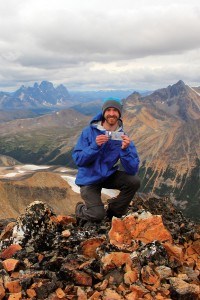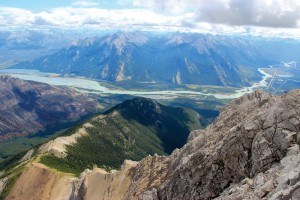
The next time you’re holding a $10 bill, take a closer look. Did you know the seven peaks found on the purple polymer note are all located in Jasper National Park?
It’s a fact few Canadians are probably aware of, but a fact Jasperite Sean Prockter was eager to exploit.
With more than 60 summits under his belt since he moved to Jasper two years ago, the avid mountaineer made it a goal to scale each mountain on the $10 bill in one summer, making him the first person to ever accomplish the feat in a single season.
“If it was just the typical peaks like Edith Cavell and Pyramid it wouldn’t have been as exciting, but every single peak I learned on that bill was an obscure peak that most people in Jasper have never heard of,” said Prockter.
“I just thought this is going to be one hell of an adventure if I actually commit to it, so sometime early in the spring this year I made the commitment to try and do it this summer,” he said.
According to the Bank of Canada, there are six peaks on the $10 bill. On the left hand side of the bill is the shoulder of Lectern Peak and Aquila Mountain. In the centre of the bill are Redan, Esplanade and Gargoyle mountains and on the right hand side is Mount Zengel, which is part of the Victoria Cross Range.
“Officially there are six peaks, according to the Bank of Canada, but there is a seventh peak that’s pretty distinguished on the bill that has no name—we’ve been calling it Ten Dollar Peak, so it was kind of like a bonus peak I did,” said Prockter, explaining the peak is the highest mountain on the right hand side of the bill.

To accomplish his goal, Prockter made a conscious effort to learn as much about each mountain as possible by talking to other climbers, reading what he could online and looking over typographical maps.
“I never really thought that I could complete it, I just kept saying that I’d like to and I have a goal to, but with mountain climbing you just never know and then suddenly it came to fruition that I had six peaks done and one to go with the snow about to fly.”
As fate would have it, his final climb up Redan Mountain, on Sept. 12, would be the toughest climb of the lot.
About a month prior to making his final ascent, a screw in his ankle from a previous injury had slowly come loose, rubbing against the inside of his mountaineering boots, making each step up and down the mountain that much more difficult.
“If it wasn’t for the fact it was my final ten dollar peak, I would not have done it,” said Prockter. “It was just sheer will that pushed me up that mountain.”
In July 2014, Prockter broke his ankle while climbing Mount Unwin. He slipped on a glacier, causing him and his climbing partner to slide nearly 200 metres down the side of the mountain before his friend was able to stop them by plunging his ice axe into the glacier.
During the fall, Prockter’s crampon caught the ice and dug in while the rest of his body kept moving, breaking his ankle in the process.
The accident forced the duo to end their journey early and required a helicopter rescue from Parks Canada.
Despite the accident, Prockter said it hasn’t stopped him from climbing, although he admitted he’s a different climber now then before the accident.
“I took the accident last year as a lesson. You’re constantly thinking about what went wrong, what could we have done better, but in the end, safety wise, we had covered all our bases, otherwise I would have been dead. It was just a freak accident.”
Although Redan Mountain wasn’t the most technical of the seven peaks, Prockter said it was by far the most difficult because of his nagging injury.
“It was all bushwhacking up Redan. Every step you’re rolling your ankle as you’re trying to go up the mountain and the pin was just scrapping along the side of my boot. It was bad.”
To get to the summit, Prockter and his climbing partner, Midori Bakonyi, had to secure themselves with ropes to ascend five pitches of varying levels of difficulty.
On the way down, the duo ran into some trouble during the final descent. Using a rock as an anchor, Prockter repelled down a gully and came across a single piton with a carabiner.
After checking the strength of the piton—a metal spike wedged into a crack in the rock—he attached himself to it and repelled down to the next ridge only to discover there were no more pitons, nor were there any boulders to anchor to.
To make matters worse, the duo forgot to bring extra pitons with them to continue the final 200 metre descent. With nothing to attach their ropes to and no boulders to be found, the duo was stuck.
To compound their problems, the sky opened up unleashing a torrent of rain.
In a bit of quick thinking, Prockter decided they would need to climb up a sketchy rock face without a rope to a nearby ridge.
“We just cautiously went up this maybe 20-metre section of fifth class rock, got up to the ridge and I found a rock that I could repel off of and quite cautiously, I slung that rock and repelled to the bottom.
“It was definitely one that was scary, but when you have a rope and gear you can adapt to everything. You can always try and find a way.”

Less than a week after completing his final summit, Prockter went into surgery to have the pin in his ankle removed, ending his climbing season until next year.
Reflecting on the seven peaks, Prockter said the most technical climb of the seven mountains was Gargoyle Mountain, which he completed on July 27.
To get to the base of the mountain it took him about five hours of hiking, followed by an extremely difficult scramble up scree.
“When I was doing it, cloud had engulfed the summit for Gargoyle so I couldn’t see 20 metres in front of me and it was a route-finding nightmare,” he recalled.
“Once I got to the summit ridge it was such a knife ridge that you could not stand on it. You either had to kind of scooch your way up like a saddle or put your hands on the ridge and take these tiny little footholds and navigate your way up it, all the while without a rope.
“I was doing it solo, so one slight mistake and I would have been dead.”
The shortest and easiest of the seven summits was Esplanade Mountain, on Sept. 4. It took him only seven hours despite it being covered in snow.
“Esplanade is the one I recommend out of all of the ten dollar peaks to do. It’s a very fun scramble, a little bit of route navigation and a fun ridge to scramble along. It’s just a really good day out,” said Prockter.
On two separate occasions, he summited two peaks in one day, including Aquila Mountain and Lectern Peak on Aug. 17 and Mount Zengel and Ten Dollar Peak on Sept. 5.
He said he decided to do the peaks together because of their close proximity to one another. He did Aquila Lectern, Gargoyle and Esplanade solo, while his friend Kai Seltner and Bakonyi joined him for Zengel. Bakonyi also climbed Ten Dollar Peak with him.
By the time the duo got to Ten Dollar Peak on Sept. 5, it was covered in snow.
“It was a full-on winter climb when I was up there because of the amount of snow, with cornices and avalanche risk,” said Prockter.
Despite undergoing surgury, Prockter said he has no plans for slowing down next year.
“No matter how many mountains I climb, there will always be more out there that I can strive for.”
Paul Clarke
[email protected]
